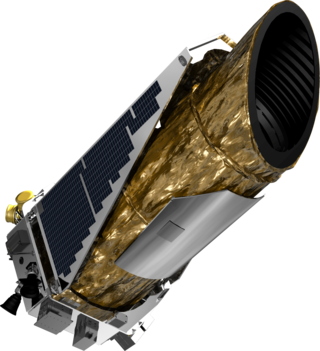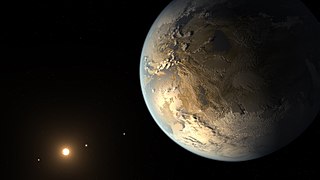Related Research Articles

An exoplanet or extrasolar planet is a planet outside the Solar System. The first possible evidence of an exoplanet was noted in 1917, but was not recognized as such. The first confirmation of the detection occurred in 1992. A different planet, initially detected in 1988, was confirmed in 2003. As of 1 September 2023, there are 5,506 confirmed exoplanets in 4,065 planetary systems, with 878 systems having more than one planet. The James Webb Space Telescope (JWST) is expected to discover more exoplanets, and also much more about exoplanets, including composition, environmental conditions and potential for life.

The Kepler space telescope is a disused space telescope launched by NASA in 2009 to discover Earth-sized planets orbiting other stars. Named after astronomer Johannes Kepler, the spacecraft was launched into an Earth-trailing heliocentric orbit. The principal investigator was William J. Borucki. After nine and a half years of operation, the telescope's reaction control system fuel was depleted, and NASA announced its retirement on October 30, 2018.

These are lists of exoplanets. As of 21 September 2023, there are 5,523 confirmed exoplanets in 4,112 planetary systems, with 932 systems having more than one planet. Most of these were discovered by the Kepler space telescope. There are an additional 1,984 potential exoplanets from Kepler's first mission yet to be confirmed, as well as 977 from its "Second Light" mission and 4,512 from the Transiting Exoplanet Survey Satellite (TESS) mission.

Any planet is an extremely faint light source compared to its parent star. For example, a star like the Sun is about a billion times as bright as the reflected light from any of the planets orbiting it. In addition to the intrinsic difficulty of detecting such a faint light source, the light from the parent star causes a glare that washes it out. For those reasons, very few of the exoplanets reported as of April 2014 have been observed directly, with even fewer being resolved from their host star.
This page describes exoplanet orbital and physical parameters.

An exoplanet is a planet located outside the Solar System. The first evidence of an exoplanet was noted as early as 1917, but was not recognized as such until 2016; no planet discovery has yet come from that evidence. What turned out to be the first detection of an exoplanet was published among a list of possible candidates in 1988, though not confirmed until 2003. The first confirmed detection came in 1992, with the discovery of terrestrial-mass planets orbiting the pulsar PSR B1257+12. The first confirmation of an exoplanet orbiting a main-sequence star was made in 1995, when a giant planet was found in a four-day orbit around the nearby star 51 Pegasi. Some exoplanets have been imaged directly by telescopes, but the vast majority have been detected through indirect methods, such as the transit method and the radial-velocity method. As of 1 September 2023, there are 5,506 confirmed exoplanets in 4,065 planetary systems, with 878 systems having more than one planet. This is a list of the most notable discoveries.
Kepler-22 is a Sun-like star in the northern constellation of Cygnus, the swan, that is orbited by a planet found to be unequivocally within the star's habitable zone. It is located at the celestial coordinates: Right Ascension 19h 16m 52.2s, Declination +47° 53′ 3.9″. With an apparent visual magnitude of 11.7, this star is too faint to be seen with the naked eye. It can be viewed with a telescope having an aperture of at least 4 in (10 cm). The estimated distance to Kepler-22 is 644 light-years.
Kepler-20 is a star about 934 light-years from Earth in the constellation Lyra with a system of at least five, and possibly six, known planets. The apparent magnitude of this star is 12.51, so it cannot be seen with the unaided eye. Viewing it requires a telescope with an aperture of 15 cm (6 in) or more. It is slightly smaller than the Sun, with 94% of the Sun's radius and about 91% of the Sun's mass. The effective temperature of the photosphere is slightly cooler than that of the Sun at 5466 K, giving it the characteristic yellow hue of a stellar class G8 star. The abundance of elements other than hydrogen or helium, what astronomers term the metallicity, is approximately the same as in the Sun. It may be older than the Sun, although the margin of error here is relatively large.

Planet Hunters is a citizen science project to find exoplanets using human eyes. It does this by having users analyze data from the NASA Kepler space telescope and the NASA Transiting Exoplanet Survey Satellite. It was launched by a team led by Debra Fischer at Yale University, as part of the Zooniverse project.

Kepler-37, also known as UGA-1785, is a G-type main-sequence star located in the constellation Lyra 209 light-years from Earth. It is host to exoplanets Kepler-37b, Kepler-37c, Kepler-37d and possibly Kepler-37e, all of which orbit very close to it. Kepler-37 has a mass about 80.3 percent of the Sun's and a radius about 77 percent as large. It has a temperature similar to that of the Sun, but a bit cooler at 5,357 K. It has about half the metallicity of the Sun. With an age of roughly 6 billion years, it is slightly older than the Sun, but is still a main-sequence star. Until January 2015, Kepler-37 was the smallest star to be measured via asteroseismology.
Kepler-68 is a Sun-like main sequence star located 471 light-years away in the constellation Cygnus. It is known to have at least four planets orbiting around it. The third planet has a mass similar to Jupiter but orbits within the habitable zone.

Kepler-37b is an exoplanet orbiting the star Kepler-37 in the constellation Lyra. As of February 2013 it is the smallest planet discovered around a main-sequence star, with a radius slightly greater than that of the Moon and slightly smaller than that of Mercury. The measurements do not constrain its mass, but masses above a few times that of the Moon give unphysically high densities.
Kepler-37d is an exoplanet discovered by the Kepler space telescope in February 2013. It is located 209 light years away, in the constellation Lyra. With an orbital period of 39.8 days, it is the largest of the three known planets orbiting its parent star Kepler-37.
Kepler-102 is a star 353 light-years away in the constellation of Lyra. Kepler-102 is less luminous than the Sun. The star system does not contain any observable amount of dust. Kepler-102 is suspected to be orbited by a binary consisting of two red dwarf stars, at projected separations of 591 and 627 AU.

GJ 9827 is a star in the constellation of Pisces. It is a K-type main-sequence star with an apparent magnitude of 10.250. It is 97 light-years away, based on parallax.
Kepler-167 is a K-type main-sequence star located about 1,119 light-years (343 pc) away from the Solar System in the constellation of Cygnus. The star has about 78% the mass and 75% the radius of the Sun, and a temperature of 4,884 K. It hosts a system of four known exoplanets. There is also a companion red dwarf star at a separation of about 700 AU, with an estimated orbital period of over 15,000 years.
References
- ↑ Barclay, T.; Rowe, J. F.; Lissauer, J. J.; Huber, D.; Fressin, F.; Howell, S. B.; Bryson, S. T.; Chaplin, W. J.; Désert, J. M. (2013-02-20). "A sub-Mercury-sized exoplanet". Nature . 494 (7438): 452–4. arXiv: 1305.5587 . Bibcode:2013Natur.494..452B. doi:10.1038/nature11914. ISSN 0028-0836. PMID 23426260. S2CID 205232792.
- 1 2 Bonomo, A. S.; Dumusque, X.; et al. (April 2023). "Cold Jupiters and improved masses in 38 Kepler and K2 small-planet systems from 3661 high-precision HARPS-N radial velocities. No excess of cold Jupiters in small-planet systems". Astronomy & Astrophysics . arXiv: 2304.05773 . doi:10.1051/0004-6361/202346211. S2CID 258078829.
- ↑ Harwood, William. "Kepler telescope spots smallest exoplanet yet". Spaceflight Now Inc. Retrieved 25 February 2013.
- ↑ Black, Charles. "NASA's Kepler discovers small planet system". SEN TV LIMITED. Archived from the original on 23 February 2013. Retrieved 25 February 2013.



